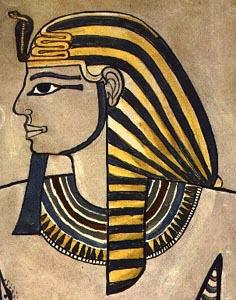KV35
| KV35 | |
|---|---|
| Burial site of Amenhotep II | |
 | |
| Coordinates | 25°44′23.6″N 32°36′0.50″E / 25.739889°N 32.6001389°E |
| Location | East Valley of the Kings |
| Discovered | March 9, 1898 |
| Excavated by | Victor Loret |
← Previous KV34 Next → KV36 | |
Tomb KV35 is an ancient Egyptian tomb located in the Valley of the Kings in Luxor, Egypt. It was discovered by Victor Loret in March 1898 and contains the tomb of Amenhotep II. Later, it was used as a cache for others.
Layout and history It has a dog's leg shape, typical of the layout of early Eighteenth Dynasty tombs, but several features make this tomb stand out. The burial chamber is a rectangular shape and divided into upper and lower pillared sections, with the lower part holding the sarcophagus of the king. This style of burial chamber became 'standard' for royal burials in the later New Kingdom.
Later the tomb was used as a mummy cache. Mummies belonging to the following individuals were relocated here during the Third Intermediate Period and were identified by inscriptions on their burial wrappings:[1][2]
- Amenhotep II (the original tomb owner found in his original sarcophagus)
Side Chamber:
- Thutmose IV
- Amenhotep III
- Merneptah
- Seti II
- Siptah
- Ramesses IV
- Ramesses V
- Ramesses VI
- Queen Tiye, who was identified as the so-called Elder Lady in February 2010 via DNA testing.
- A prince, identified by some as Webensenu son of Amenhotep II whose canopic jars were found in the tomb or Thutmose, elder son of Amenhotep III and Tiye
- The Younger Lady who, in June 2003, was controversially claimed to be Nefertiti by British Egyptologist Joann Fletcher, whereas Egyptologist Zahi Hawass believed it to be Kiya, another wife of Akhenaten who is believed by some to be the birth mother of Tutankhamun. Some believed this mummy to be a male.[3] However, with DNA testing, this mummy was shown in February 2010 to be a woman, the mother of Tutankhamun, and the daughter of Amenhotep III and Tiye (making her both the sister and wife of Akhenaten). Her name, however, remains unknown, leaving open the possibility that she is likely either Nebetiah or Beketaten.
- An unknown woman D in an upturned lid of a coffin inscribed for Setnakhte (may be queen Tawosret).
- Two skulls were found in the well and an anonymous arm was found with the above "Younger Lady". A body on a boat was stolen from or destroyed at the start of the twentieth century.

References
- ^ Theban Mapping Project - Site History
- ^ www.narmer.pl - Valley of the Kings - KV35.
- ^ CBC News: Blockbuster Science - More 'Daddy' than 'Mummy'? Archived May 4, 2007, at the Wayback Machine

